Impact of Technology on Early Childhood Education: A Detailed Analysis
VerifiedAdded on 2022/08/17
|5
|1167
|16
Report
AI Summary
This report delves into the significant role of technology in early childhood education, highlighting its positive effects on children's development and learning. It explores how technology enhances teaching methods, promotes active learning, and provides access to innovative educational tools. The report examines the evolution of instructional models and approaches, emphasizing the importance of developmentally appropriate technology use, authentic assessment strategies, and the promotion of equity through technology. It also discusses effective communication methods with parents using technology and provides insights into integrating technology into classrooms. Furthermore, it addresses the need for planning, budgeting, and curating high-quality digital learning materials. The report also includes a reference list of the sources used in the report.
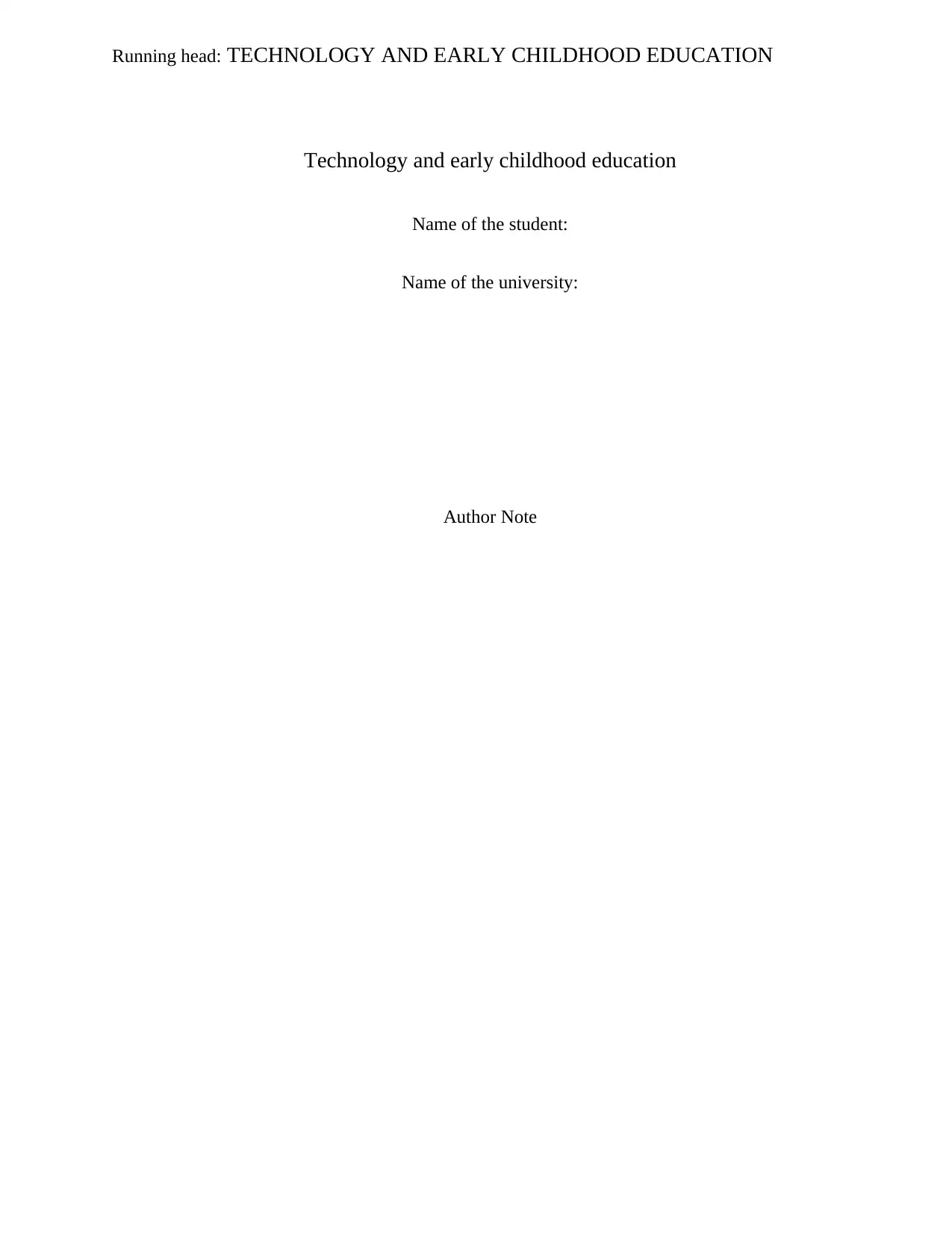
Running head: TECHNOLOGY AND EARLY CHILDHOOD EDUCATION
Technology and early childhood education
Name of the student:
Name of the university:
Author Note
Technology and early childhood education
Name of the student:
Name of the university:
Author Note
Paraphrase This Document
Need a fresh take? Get an instant paraphrase of this document with our AI Paraphraser
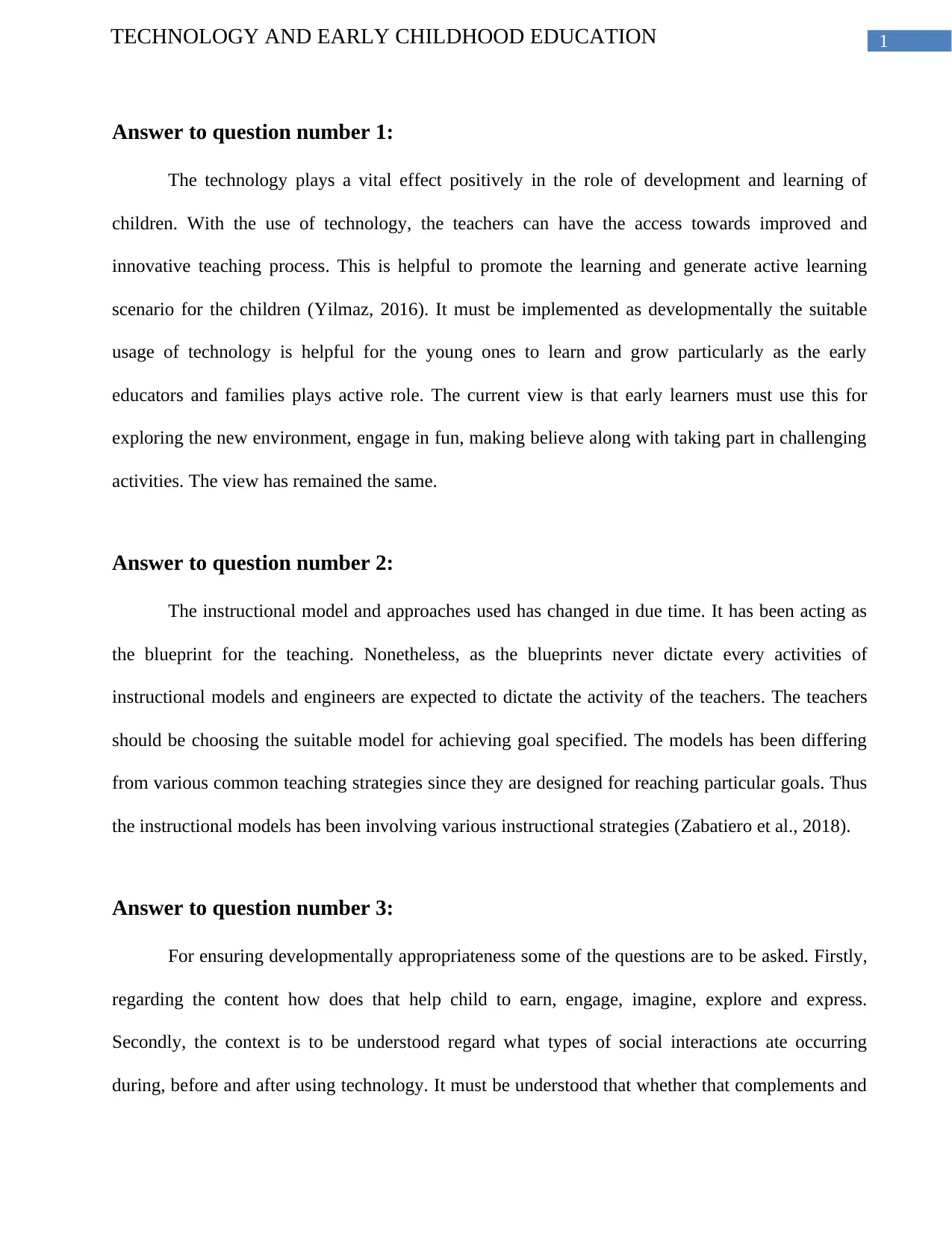
1TECHNOLOGY AND EARLY CHILDHOOD EDUCATION
Answer to question number 1:
The technology plays a vital effect positively in the role of development and learning of
children. With the use of technology, the teachers can have the access towards improved and
innovative teaching process. This is helpful to promote the learning and generate active learning
scenario for the children (Yilmaz, 2016). It must be implemented as developmentally the suitable
usage of technology is helpful for the young ones to learn and grow particularly as the early
educators and families plays active role. The current view is that early learners must use this for
exploring the new environment, engage in fun, making believe along with taking part in challenging
activities. The view has remained the same.
Answer to question number 2:
The instructional model and approaches used has changed in due time. It has been acting as
the blueprint for the teaching. Nonetheless, as the blueprints never dictate every activities of
instructional models and engineers are expected to dictate the activity of the teachers. The teachers
should be choosing the suitable model for achieving goal specified. The models has been differing
from various common teaching strategies since they are designed for reaching particular goals. Thus
the instructional models has been involving various instructional strategies (Zabatiero et al., 2018).
Answer to question number 3:
For ensuring developmentally appropriateness some of the questions are to be asked. Firstly,
regarding the content how does that help child to earn, engage, imagine, explore and express.
Secondly, the context is to be understood regard what types of social interactions ate occurring
during, before and after using technology. It must be understood that whether that complements and
Answer to question number 1:
The technology plays a vital effect positively in the role of development and learning of
children. With the use of technology, the teachers can have the access towards improved and
innovative teaching process. This is helpful to promote the learning and generate active learning
scenario for the children (Yilmaz, 2016). It must be implemented as developmentally the suitable
usage of technology is helpful for the young ones to learn and grow particularly as the early
educators and families plays active role. The current view is that early learners must use this for
exploring the new environment, engage in fun, making believe along with taking part in challenging
activities. The view has remained the same.
Answer to question number 2:
The instructional model and approaches used has changed in due time. It has been acting as
the blueprint for the teaching. Nonetheless, as the blueprints never dictate every activities of
instructional models and engineers are expected to dictate the activity of the teachers. The teachers
should be choosing the suitable model for achieving goal specified. The models has been differing
from various common teaching strategies since they are designed for reaching particular goals. Thus
the instructional models has been involving various instructional strategies (Zabatiero et al., 2018).
Answer to question number 3:
For ensuring developmentally appropriateness some of the questions are to be asked. Firstly,
regarding the content how does that help child to earn, engage, imagine, explore and express.
Secondly, the context is to be understood regard what types of social interactions ate occurring
during, before and after using technology. It must be understood that whether that complements and
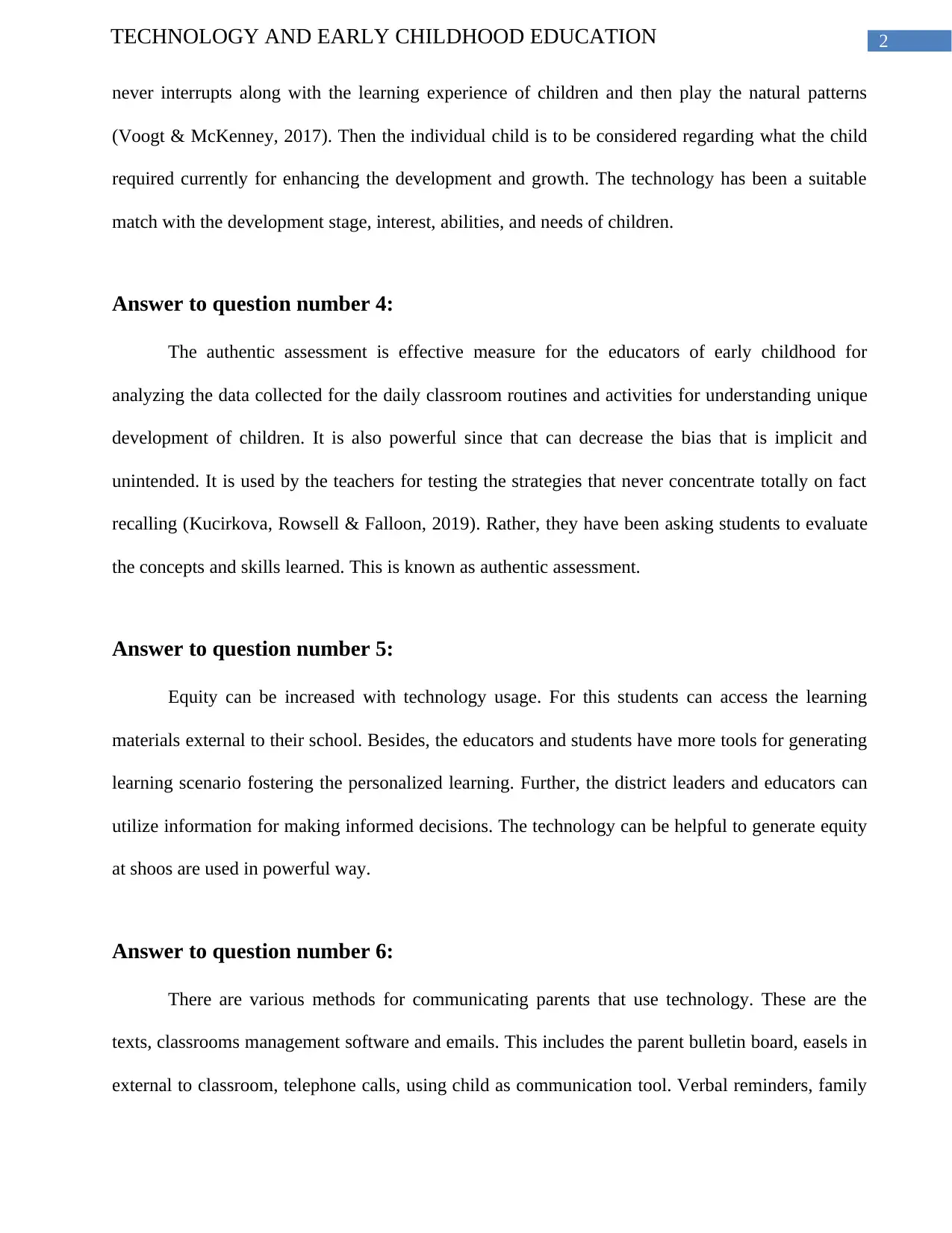
2TECHNOLOGY AND EARLY CHILDHOOD EDUCATION
never interrupts along with the learning experience of children and then play the natural patterns
(Voogt & McKenney, 2017). Then the individual child is to be considered regarding what the child
required currently for enhancing the development and growth. The technology has been a suitable
match with the development stage, interest, abilities, and needs of children.
Answer to question number 4:
The authentic assessment is effective measure for the educators of early childhood for
analyzing the data collected for the daily classroom routines and activities for understanding unique
development of children. It is also powerful since that can decrease the bias that is implicit and
unintended. It is used by the teachers for testing the strategies that never concentrate totally on fact
recalling (Kucirkova, Rowsell & Falloon, 2019). Rather, they have been asking students to evaluate
the concepts and skills learned. This is known as authentic assessment.
Answer to question number 5:
Equity can be increased with technology usage. For this students can access the learning
materials external to their school. Besides, the educators and students have more tools for generating
learning scenario fostering the personalized learning. Further, the district leaders and educators can
utilize information for making informed decisions. The technology can be helpful to generate equity
at shoos are used in powerful way.
Answer to question number 6:
There are various methods for communicating parents that use technology. These are the
texts, classrooms management software and emails. This includes the parent bulletin board, easels in
external to classroom, telephone calls, using child as communication tool. Verbal reminders, family
never interrupts along with the learning experience of children and then play the natural patterns
(Voogt & McKenney, 2017). Then the individual child is to be considered regarding what the child
required currently for enhancing the development and growth. The technology has been a suitable
match with the development stage, interest, abilities, and needs of children.
Answer to question number 4:
The authentic assessment is effective measure for the educators of early childhood for
analyzing the data collected for the daily classroom routines and activities for understanding unique
development of children. It is also powerful since that can decrease the bias that is implicit and
unintended. It is used by the teachers for testing the strategies that never concentrate totally on fact
recalling (Kucirkova, Rowsell & Falloon, 2019). Rather, they have been asking students to evaluate
the concepts and skills learned. This is known as authentic assessment.
Answer to question number 5:
Equity can be increased with technology usage. For this students can access the learning
materials external to their school. Besides, the educators and students have more tools for generating
learning scenario fostering the personalized learning. Further, the district leaders and educators can
utilize information for making informed decisions. The technology can be helpful to generate equity
at shoos are used in powerful way.
Answer to question number 6:
There are various methods for communicating parents that use technology. These are the
texts, classrooms management software and emails. This includes the parent bulletin board, easels in
external to classroom, telephone calls, using child as communication tool. Verbal reminders, family
⊘ This is a preview!⊘
Do you want full access?
Subscribe today to unlock all pages.

Trusted by 1+ million students worldwide
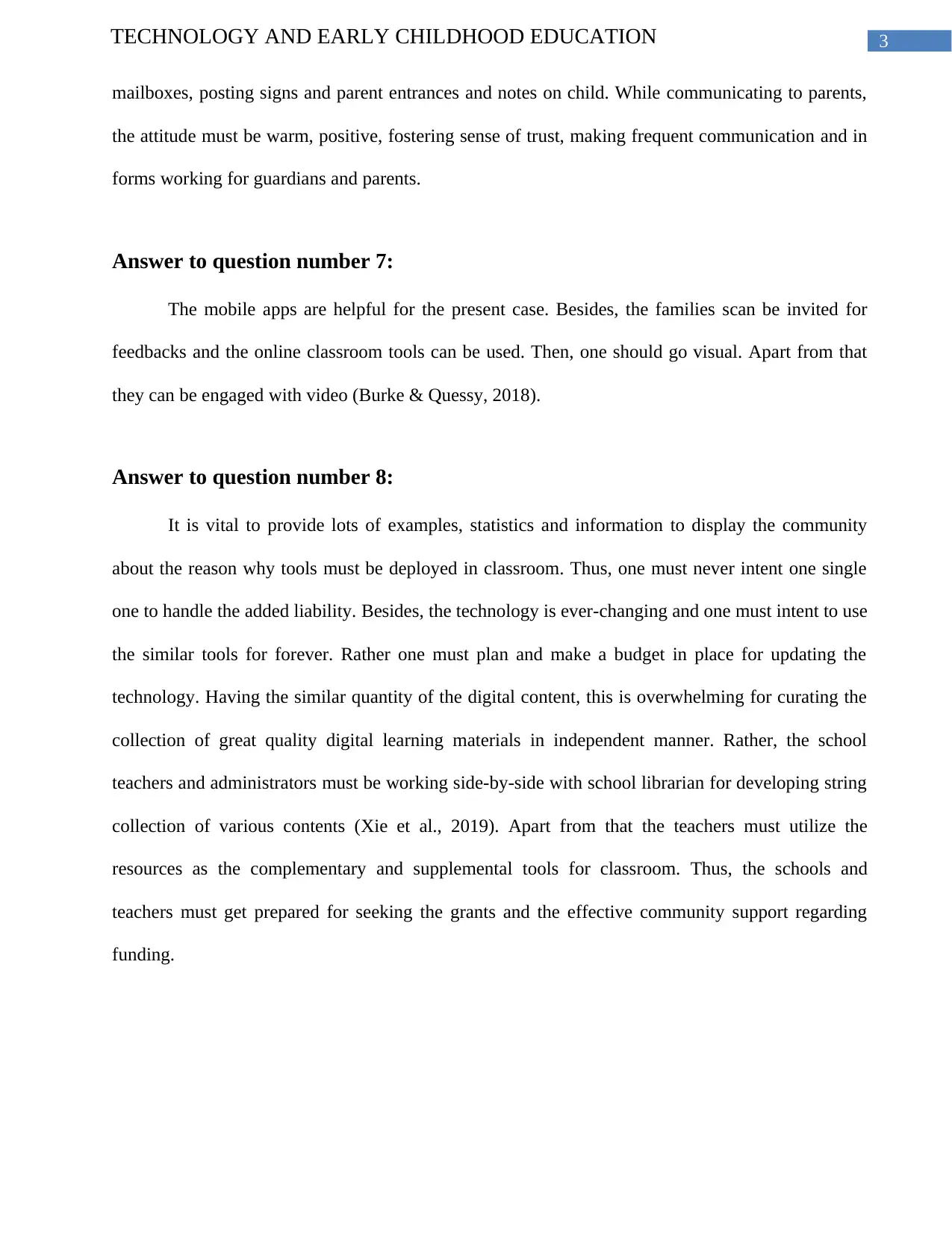
3TECHNOLOGY AND EARLY CHILDHOOD EDUCATION
mailboxes, posting signs and parent entrances and notes on child. While communicating to parents,
the attitude must be warm, positive, fostering sense of trust, making frequent communication and in
forms working for guardians and parents.
Answer to question number 7:
The mobile apps are helpful for the present case. Besides, the families scan be invited for
feedbacks and the online classroom tools can be used. Then, one should go visual. Apart from that
they can be engaged with video (Burke & Quessy, 2018).
Answer to question number 8:
It is vital to provide lots of examples, statistics and information to display the community
about the reason why tools must be deployed in classroom. Thus, one must never intent one single
one to handle the added liability. Besides, the technology is ever-changing and one must intent to use
the similar tools for forever. Rather one must plan and make a budget in place for updating the
technology. Having the similar quantity of the digital content, this is overwhelming for curating the
collection of great quality digital learning materials in independent manner. Rather, the school
teachers and administrators must be working side-by-side with school librarian for developing string
collection of various contents (Xie et al., 2019). Apart from that the teachers must utilize the
resources as the complementary and supplemental tools for classroom. Thus, the schools and
teachers must get prepared for seeking the grants and the effective community support regarding
funding.
mailboxes, posting signs and parent entrances and notes on child. While communicating to parents,
the attitude must be warm, positive, fostering sense of trust, making frequent communication and in
forms working for guardians and parents.
Answer to question number 7:
The mobile apps are helpful for the present case. Besides, the families scan be invited for
feedbacks and the online classroom tools can be used. Then, one should go visual. Apart from that
they can be engaged with video (Burke & Quessy, 2018).
Answer to question number 8:
It is vital to provide lots of examples, statistics and information to display the community
about the reason why tools must be deployed in classroom. Thus, one must never intent one single
one to handle the added liability. Besides, the technology is ever-changing and one must intent to use
the similar tools for forever. Rather one must plan and make a budget in place for updating the
technology. Having the similar quantity of the digital content, this is overwhelming for curating the
collection of great quality digital learning materials in independent manner. Rather, the school
teachers and administrators must be working side-by-side with school librarian for developing string
collection of various contents (Xie et al., 2019). Apart from that the teachers must utilize the
resources as the complementary and supplemental tools for classroom. Thus, the schools and
teachers must get prepared for seeking the grants and the effective community support regarding
funding.
Paraphrase This Document
Need a fresh take? Get an instant paraphrase of this document with our AI Paraphraser
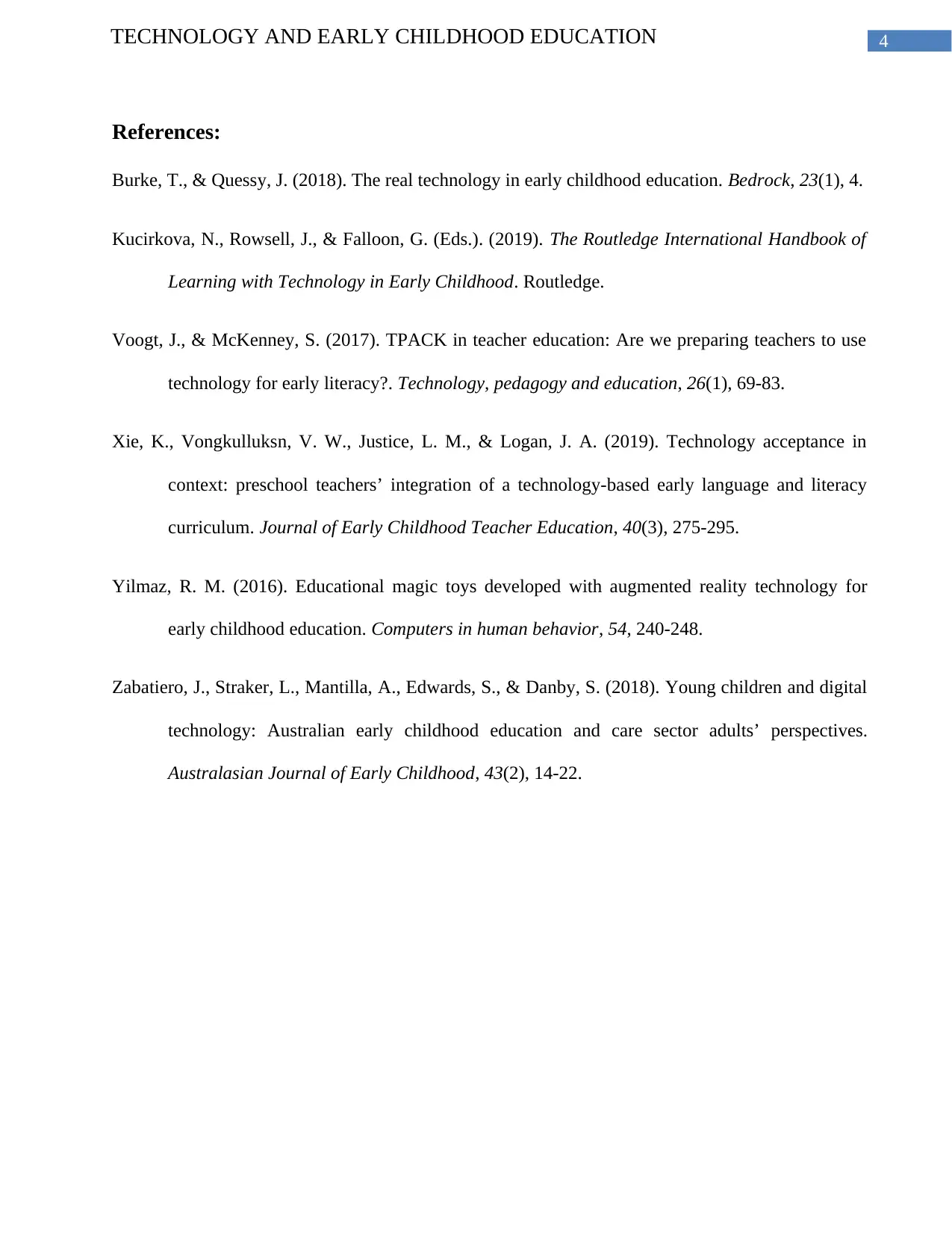
4TECHNOLOGY AND EARLY CHILDHOOD EDUCATION
References:
Burke, T., & Quessy, J. (2018). The real technology in early childhood education. Bedrock, 23(1), 4.
Kucirkova, N., Rowsell, J., & Falloon, G. (Eds.). (2019). The Routledge International Handbook of
Learning with Technology in Early Childhood. Routledge.
Voogt, J., & McKenney, S. (2017). TPACK in teacher education: Are we preparing teachers to use
technology for early literacy?. Technology, pedagogy and education, 26(1), 69-83.
Xie, K., Vongkulluksn, V. W., Justice, L. M., & Logan, J. A. (2019). Technology acceptance in
context: preschool teachers’ integration of a technology-based early language and literacy
curriculum. Journal of Early Childhood Teacher Education, 40(3), 275-295.
Yilmaz, R. M. (2016). Educational magic toys developed with augmented reality technology for
early childhood education. Computers in human behavior, 54, 240-248.
Zabatiero, J., Straker, L., Mantilla, A., Edwards, S., & Danby, S. (2018). Young children and digital
technology: Australian early childhood education and care sector adults’ perspectives.
Australasian Journal of Early Childhood, 43(2), 14-22.
References:
Burke, T., & Quessy, J. (2018). The real technology in early childhood education. Bedrock, 23(1), 4.
Kucirkova, N., Rowsell, J., & Falloon, G. (Eds.). (2019). The Routledge International Handbook of
Learning with Technology in Early Childhood. Routledge.
Voogt, J., & McKenney, S. (2017). TPACK in teacher education: Are we preparing teachers to use
technology for early literacy?. Technology, pedagogy and education, 26(1), 69-83.
Xie, K., Vongkulluksn, V. W., Justice, L. M., & Logan, J. A. (2019). Technology acceptance in
context: preschool teachers’ integration of a technology-based early language and literacy
curriculum. Journal of Early Childhood Teacher Education, 40(3), 275-295.
Yilmaz, R. M. (2016). Educational magic toys developed with augmented reality technology for
early childhood education. Computers in human behavior, 54, 240-248.
Zabatiero, J., Straker, L., Mantilla, A., Edwards, S., & Danby, S. (2018). Young children and digital
technology: Australian early childhood education and care sector adults’ perspectives.
Australasian Journal of Early Childhood, 43(2), 14-22.
1 out of 5
Related Documents
Your All-in-One AI-Powered Toolkit for Academic Success.
+13062052269
info@desklib.com
Available 24*7 on WhatsApp / Email
![[object Object]](/_next/static/media/star-bottom.7253800d.svg)
Unlock your academic potential
Copyright © 2020–2025 A2Z Services. All Rights Reserved. Developed and managed by ZUCOL.





